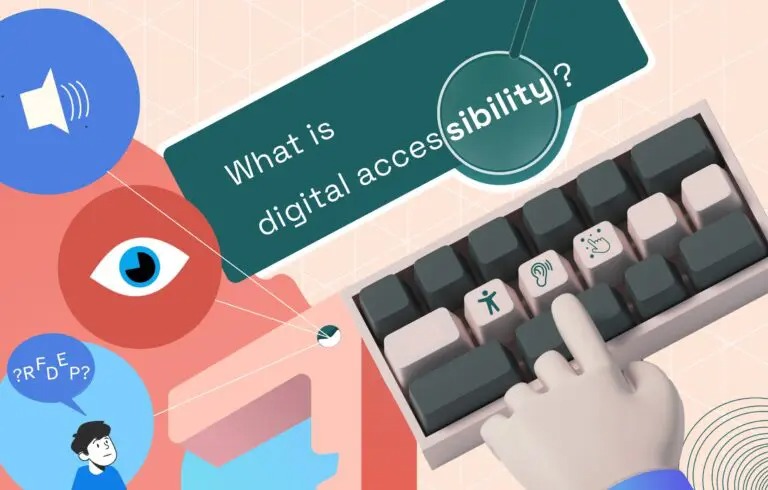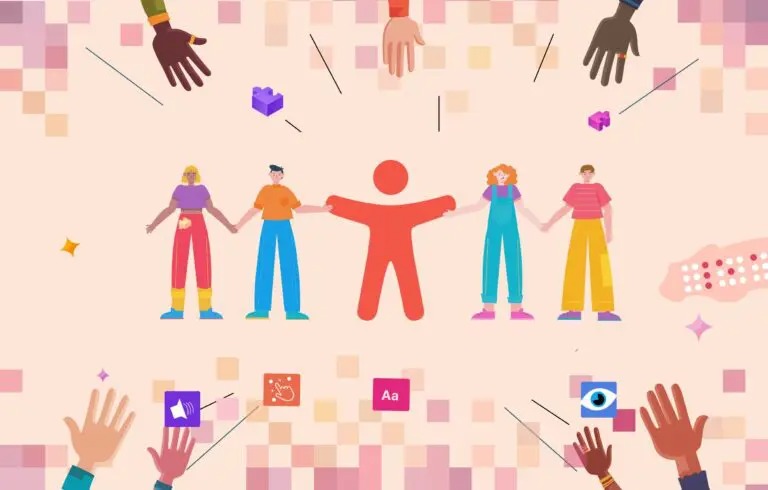Digital accessibility is all about creating websites, apps, and internet technologies – that is, digital experiences, accessible to anyone, regardless of the impairment they face. The purpose of designing with accessibility in mind is to provide a more unbiased internet experience for all; one where the experience, perception, accessibility, understanding, interaction, and participation with fellow web surfers is possibly for persons with physical or cognitive disabilities as it is for able bodied people.
Stuti Mazumdar & Vidhi Tiwari - April 2024

What is Digital Accessibility?
In today’s technology-driven world, accessibility to digital content and technology has become more important than ever before. However, many individuals with disabilities have faced significant barriers in accessing and utilizing digital content. To bridge the gap between relevant information and specially-abled individuals, special efforts are made to craft accessible experiences.

Web or digital accessibility is the inclusive practice of making websites, digital tools, and technologies accessible and usable for people with disabilities. When digital accessibility is achieved, it means people with disabilities can successfully perceive, understand, navigate, interact with, and contribute to the online world.
Why Does it Matter?
Walking into a healthcare facility, you would expect to be treated the same as any different person walking in with you. The same goes for schools and colleges, government facilities, or something as common as a grocery store. All experiences should be similar, if not identical, and accessible to people with disabilities at all times. After all, it is only fundamentally right that everyone has access to the same content, since diversity, equity, and inclusion are the cornerstones for a utopian digital experience that we aim for.

In an era where technology permeates every aspect of our lives, from education and employment to communication and entertainment, excluding individuals with disabilities from digital spaces perpetuates inequality and restricts their opportunities. Embracing digital accessibility not only aligns with principles of inclusivity and diversity but also makes good business sense. With one in five people identifying with a disability statistic, it only is in the benefit of an organization to ensure all content and products are devised to be accessible to estimate an increase in their market share by 20%. That is to say, a more accessible digital environment enhances user satisfaction, expands market reach, and fosters innovation by tapping into the diverse perspectives and talents of a broader audience. Moreover, as legal frameworks worldwide increasingly mandate digital inclusivity, organizations that prioritize accessibility are not only meeting regulatory requirements but also contributing to a more equitable and just society. Ultimately, digital accessibility is a fundamental right, empowering individuals with disabilities to navigate and contribute to the digital landscape on equal terms.
Furthermore, by virtue of implementing accessibility standards, we ensure that everyone, regardless of their physical or cognitive disabilities, can fully participate in the digital world. And by extension, hold the power to impact the real world.
The History of Accessibility
The history of digital accessibility is a testament to the progress made in recognizing the importance of inclusivity in the digital realm. From the early days of computing to the present, the journey towards accessibility has been marked by collaboration, legislation, technological advancements, and a growing awareness of the diverse needs of individuals with disabilities.
The Rehabilitation Act of 1973
The Rehabilitation Act of 1973 marked the beginning of the legal acceptance of accessibility by the government. A critical law was passed prohibiting federal agencies and third-party contractors from actively or passively discriminating against individuals with physical or cognitive disabilities. Abstaining from providing employment, financial assistance, and other amenities would’ve, thus, landed these agencies in trouble.
Americans with Disabilities Act (1990)
The Americans with Disabilities Act was released in 1990, commonly referred to as the ADA. It consisted of guidelines on making public spaces, such as parks, malls, movie theaters, etc. more accessible for specially-abled individuals through physical means, including wheelchair ramps, larger stalls, railings on staircases, braille on elevator buttons, etc.
As an extension, Tim Berners Lee considered making the World Wide Web an accessible experience. In 1996, the Department of Justice, DOJ, followed suit and accepted websites as a matter of “public accommodation” to further the cause.
Maguire v Sydney Organizing Committee (1999/2000)
Several years following the impactful statement by the Department of Justice (DOJ) regarding the application of Title III to digital content, Bruce Maguire initiated legal proceedings against the Sydney Organizing Committee for the Olympic Games (SOCOG). Grounded in Australia’s Disability Discrimination Act, Maguire contended that SOCOG had discriminated against him and several other visually impaired individuals by neglecting to provide information in Braille format for ticket orders, not offering the souvenir program in Braille, and maintaining an inaccessible website. Despite SOCOG’s vigorous defense, Maguire ultimately emerged victorious, leading the court to mandate the remediation of SOCOG’s website. This case prompted the Australian government to promptly direct its agency websites to adhere to the ADA guidelines set by the W3G.
Amendment of Section 508 (1998)
To expand the Rehabilitation Act of 1973, Section 508 was pushed to effect on the contractors for the federal government. It stated that organizations and the federal government wanting to pursue business with the government need to have accessible digital content and assets.
Owing to the lack of knowledge about technology, this act coming to light was a milestone that set the course of the internet that we know today.
Web Content Accessibility Guidelines (WCAG 1.0) Released (1999)
Tim Berners Lee, a keen advocate for accessible web experiences for individuals with disabilities, along with his web guidelines group, introduced us to WCAG 1.0 in 1999. It included 14 guidelines, with each covering a specific element of web accessibility, and provided 65 checkpoints to make the web a more inclusive place.
WCAG 2.0 Released (2008)
A decade after releasing the WCAG 1.0, the web guidelines group released an updated version, WCAG 2.0. Building on its predecessor, it comprised four principles namely, perceivable, operable, understandable, and robust. They paired these principles with more guidelines for developers to ensure an accessible web experience for all users.
WCAG 2.1 Released (2018)
After another decade, the web guidelines group released yet another version of the web content accessibility guidelines, WCAG 2.1. It emphasized the plight of the underrepresented who were missed when putting together WCAG 2.0. This included more information on accommodating those with cognitive disabilities. These included different kinds of impairments including:
- Auditory
- Cognitive/intellectual
- Neurological (including neurodiverse, epilepsy, etc.)
- Physical
- Speech
- Visual
What Makes Digital Content Accessible?
The Web Content Accessibility Guidelines, WCAG, identified four principles to define accessible digital experiences – POUR.
1. Perceivable: People can perceive digital content through one of their senses. For instance, individuals with visual impairment can access information on a web page through a screen reader.
2. Operable: People can use interactive elements for an altered digital experience content. For instance, individuals with limited hand mobility can use diction software to click buttons.
3. Understandable: People should be able to have access to consistent and predictable content, making it easy to use. For instance, individuals using assistive technologies should be able to identify links and clicks quickly and seamlessly.
4. Robust: People should have access to websites and other digital experiences that are crafted following the accessibility standards.
Emerging Technologies Driving Accessibility
As technology continues to evolve, so do the challenges and opportunities for digital accessibility. Emerging technologies such as VR and AR open new doors for opportunities. Ensuring that these technologies are accessible to individuals with disabilities requires consistent efforts in research, development, and collaboration within the tech industry.
While AI-powered tools hold the capacity to generate image descriptions, improve speech-to-text accuracy, and enhance the usability of digital interfaces for individuals with cognitive disabilities, it is crucial to ensure that AI technologies themselves are developed with accessibility in mind.
Accessibility Advocacy Through Social Media
Social media platforms are becoming powerful tools for advocacy, allowing individuals with physical or cognitive disabilities to connect with the world around them, talk about their experiences, and raise awareness about the issues they face. Social media played a crucial role in amplifying the voices of those advocating for more inclusive digital spaces.
In response to the growing pressure, major social media platforms implemented accessibility features. For instance, alt text for images, autogenerated closed captioning for videos, etc.
The history of digital accessibility reflects the efforts of passionate individuals and organizations. We’ve witnessed the journey of accessible digital experiences from the early days of assistive technology to the era of mobile phones all the way to emerging technology. However, there is still work to be done to ensure that digital experiences are inclusive for all.
While significant progress has been made in the field of digital accessibility, challenges still remain. Websites and applications continue to be developed without considering accessibility, resulting in exclusion for individuals with disabilities. Additionally, new technologies may introduce unforeseen barriers that need to be addressed promptly. Maintaining a commitment to inclusivity requires continued education, awareness, and collaboration among stakeholders.
Aside from being morally ethical, digital accessibility as a concept can prove to be a boon in advancements across industries. With innovation front-running all technological initiatives, offering personalized, hyperconnected, secure, and accessible experiences to every individual across the world would be a substantial waste of technological potential.




